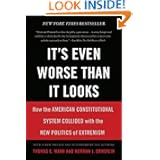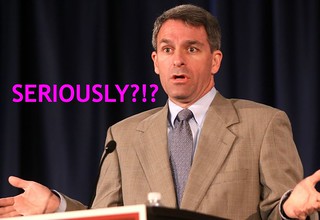( – promoted by lowkell)
 I was planning on turning to the Attorney General’s race next, but for a number of reasons I’m going to look at the House of Delegates first.
I was planning on turning to the Attorney General’s race next, but for a number of reasons I’m going to look at the House of Delegates first.
In 2001, Democrats broke back into the Governor’s Mansion in Richmond after eight years with Mark Warner trouncing Mark Earley. Along the way, Warner helped Richmond Mayor Tim Kaine win as Lt. Governor, but he couldn’t get Donald McEachin over the finish line against Jerry Kilgore. More importantly, the Warner-Kaine victory came despite a Republican landslide at the House of Delegates level, mainly due to the new Republican gerrymandering. As Democrats look to sweep at least the top two spots in Virginia on November 5, how are their chances in the House of Delegates looking?
Under the new Republican-drawn lines, Obama won only 45 House of Delegates districts, despite his statewide victory. Tim Kaine won an additional six and was close in several more. Although McAuliffe could poll as high as 52%, the internal polling indicates that there will be some variance compared to Obama’s similar statewide victory in 2012. Let’s look at this regionally.
Central & Western Virginia
Democrats are running slightly ahead of their 2012 performance, but given the landslide for Romney in this region, that’s not going to do much to put districts in play. Despite the vocal promises of the Democratic Party, Delegate Joe Johnson’s open seat was turned over to Republicans without a contest. And with good reason, as the district is one of the most Republican in Virginia. Even with better performance this year, I will be surprised if the Democratic ticket cracks 40% here.
In all of these districts, even Democratic ones like the 11th, Obama ran behind his 2008 performance in 2012. There may be some districts where a strong performance this year could see the ticket reach closer to 45%. The 7th could be one of those, because the influence of Blacksburg bleeds into even the non-12th parts of Montgomery County. The 12th is the only district that is in play in this area. We’ll focus on that race later.
DC Suburbs
The counter to Central and Western Virginia, this is the most Democratic portion of the state. Within Fairfax County, there are five Republican delegates (from most Republican district to least): 40th (Hugo), 34th (Comstock), 42nd (Albo), 67th (LeMunyon), and 86th (Rust). We’ve seen good internal polls in the 34th and 86th, but the other races here are already over. That’s disappointing, because except for the 40th, I expect Democrats to win all these districts in the statewide races, and I believe the chances of them winning the 40th are at least 50-50. Picking up two seats will be good, but Democrats have to find better candidates in the 67th and 42nd, and start campaigning earlier, next time around.
In the 34th, McAullife is doing better than expected, a sign that the emphasis on social issues is working in this affluent seat. This is a more difficult seat for Democrats than it appears, because of the influence of wealthy voters. It can swing hard to Democrats in some elections – social issues and the Iraq War moved it sharply to Democrats in 2006. But during a campaign that focuses on economic issues the Republicans can move large blocks of voters. It was, for example, the only Republican-held DC suburban district to shift away from Obama in 2012 compared to his 2008 result, even though Obama still won.
Northern Virginia Exurbs
As a reminder, this isn’t just Prince William and Loudoun County, it spreads out all the way to Spotsylvania, Stafford, Culpeper, Warren, and Frederick. And while there are competitive seats, there’s only one Democrat in this area, Luke Torian.
Both the 2nd and the 87th are strong Democratic districts with presidential turnout, and the 87th shows a 47%-47% tie right now with McAuliffe up 7 points in the head-to-head. That’s a little down from what I’d expect from the district on election day, but I also believe that there will be turnout problems in more diverse districts in the exurbs. That’s also the problem in a district like the 13th, which is very diverse (and getting more diverse), but will continue to lag behind its presidential performance until Democrats find a way to mobilize voters in odd years. Depending on turnout, McAuliffe may defeat Cuccinelli in several competitive districts like the 13th, but with Sarvis holding the difference. I wouldn’t be surprised if Obenshain pulls off narrow victories as Democratic strength weakens down-ballot.
This region also includes the 33rd, where Tea Partier David LaRock defeated incumbent Joe May earlier this year in the GOP primary. Democrats recruited a strong candidate in Mary Daniel and are doing the best they can. They know that this open seat situation is their only chance at this otherwise safe Republican district. Although I support contesting every seat, I have my doubts that this seat could flip, even under these ideal circumstances. The district starts off as too Republican; the 33rd and the neighboring 10th also swung toward Romney in 2012 while more diverse seats saw Obama holding steady or improving. With polling showing that McAuliffe hasn’t hit his stride in the exurbs yet, I think the 33rd is going to be a long shot no matter what.
Richmond & Eastern Virginia
Not just Metro Richmond, this includes portions of Southside that don’t fit into Tidewater or the definition of Central and Western Virginia. Because of Richmond and large minority populations in other centers like Petersburg, this area tends to be very competitive overall in big turnout years. This year, Democrats look to be doing better than they did even in 2012, which may be a mixture of better African-American turnout than usual (relative to it being lower in odd years) or a swing among Richmond suburbanites. The polling has African-Americans at 16% of likely voters, down from 20% in 2012, so I think the action here is more among swing voters.
Because of the Voting Rights Act, the Democratic districts here are overwhelmingly Democratic, weakening performance elsewhere and minimizing potential gains. There are, however, five Richmond suburban seats (62nd, 72nd, 73rd, 27th, and 68th) that can be competitive. The combination of decent Obama performance and Tim Kaine’s specific Richmond appeal meant several were won by Tim Kaine in 2012. If McAuliffe is running better than expected in the Richmond suburbs, he’ll be breaking 46% or outright winning them, but there are few signs that the local candidates are strong enough to build on this…because there aren’t any local candidates! That’s right: in all of five of these seats, Democrats failed to recruit a candidate. The weak farm team here means that Republicans go uncontested, hurting our chances long term when seats open up or we have special elections.
I’ll also touch on two districts that I don’t think fit in this region, but based on the lack of a Southside region are probably here anyway: Danville’s 14th and Halifax’s 60th. African Americans make up over a third of these districts, but strong Republican voting patterns by white voters produce close elections. The 14th is a little bit more Democratic and has drawn more attention this year, but Danny Marshall is swamping his Democratic opponent so far in fundraising. Gary Miller has the backing of the party and is working with the same set of consultants as other top races, but I haven’t heard anything positive leaked about the campaign so far. That could be a sign that he’s not performing well, or Democrats may not want to send up a red flag that the GOP should flood this district and squash Miller. If Miller wins, it’s going to be on the back of a narrow McAuliffe victory in the district from a turnout advantage. If I was involved in the race, I’d keep my mouth shut even if it is close.
Tidewater
A range of districts from the heavily Democratic minority-majority to the open seat in the 78th, which is the most Republican of any Tidewater seat. That must be why the House Caucus has given $6,000 to the Democratic challenger Linda Bryant, why other top Democrats are writing checks, and why Delegate Toscano’s PAC has thrown in $5,000. I admire the intent, trying to compete in open seats, but I question the district. I will be impressed if McAullife breaks 42% here, or maybe even 40%; if he does it’s a sign of how bad this year is for Republicans.
The most competitive district here is the 93rd, where Republican Mike Watson is running on his support of transportation and in conflict with the messaging at the top of his ticket. There are a handful of Virginia Beach districts, including the open 85th, but I don’t see the same level of support from the party. They did a poll back in August and whatever they saw convinced them to stay out. Which is why I question the decision to get into the 78th, if the 85th does not look good for Democrats this year, how can the 78th? The 94th has also attracted attention and should be a close race on election day at the top of the ticket, we’ll see how that trickles down.
Final Count
Competitive Races: 12th (Central & Western), 34th and 86th (DC Suburbs), 2nd and 87th (Northern Virginia Exurbs), 14th (Richmond & Eastern Virginia), and 93rd (Tidewater).
If it’s a Good Democratic Night: 13th, 31st, 32nd, and 51st (Northern Virginia Exurbs), and 94th (Tidewater).
Most of these (all of the Northern Virginia Exurbs, and the 14th) will depend on the fundamentals at the top of the ticket, what’s driving turnout, and what the electorate looks like.
This far out, it looks like Democrats are on track to pick up three to five seats, and then back down one with the Johnson seat already gone. There are no vulnerable Democratic incumbents. If anyone goes down to defeat this year it’s their own damn fault. Because so many seats are being driven by fundamentals of turnout at the top of the ticket, and are in similar areas with similar demographics, I could easily see a great Democratic night producing much higher gains, closer to seven or eight. The biggest disappointment could be in Richmond, where McAuliffe and the Democratic ticket may actually win several districts that were not even contested locally.

 Ken Cuccinelli is rallying with several Attorneys General today. Needless to say, they’re all very, VERY far to the right. Let’s just take one example – Florida AG Pam Bondi – as illustrative. Here are a few things you might want to know about Bondi.
Ken Cuccinelli is rallying with several Attorneys General today. Needless to say, they’re all very, VERY far to the right. Let’s just take one example – Florida AG Pam Bondi – as illustrative. Here are a few things you might want to know about Bondi.
 You probably have heard about the book from a little while back, It’s Even Worse Than It Looks. It was written by two very centrist, perhaps even conservative, interpreters of the Washington scene: Norm Ornstein (of the American Enterprise Institute) and Thomas Mann (of the Brookings Institution).
You probably have heard about the book from a little while back, It’s Even Worse Than It Looks. It was written by two very centrist, perhaps even conservative, interpreters of the Washington scene: Norm Ornstein (of the American Enterprise Institute) and Thomas Mann (of the Brookings Institution). All eyes on Virginia. Governor Howard Dean and Purple to Blue 86th District House of Delegates candidate
All eyes on Virginia. Governor Howard Dean and Purple to Blue 86th District House of Delegates candidate  Before we provide the highlights from today’s Republican…er,
Before we provide the highlights from today’s Republican…er, 




